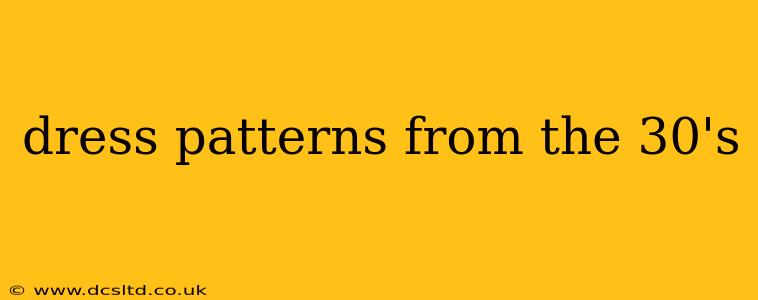The 1930s, a decade bridging the flapper era and the impending war, offered a fascinating evolution in women's fashion. Dress patterns reflected this shift, moving away from the loose, boyish silhouettes of the late 1920s towards more defined, feminine shapes. This journey through 1930s dress patterns explores the key styles, influences, and the enduring appeal of this era's fashion.
What were the popular dress styles of the 1930s?
The 1930s saw a fascinating blend of styles. The early years still held echoes of the flapper era, but a clear move towards more structured and elegant designs became increasingly prominent. Bias-cut gowns, emphasizing a flowing, figure-skimming silhouette, became incredibly popular. These dresses often featured subtle draping and intricate detailing, creating a sophisticated and glamorous look. Later in the decade, a more tailored look emerged, with defined shoulders and a nipped-in waist, reflecting the influence of Hollywood glamour. A-line dresses also gained traction, offering a more relaxed yet still elegant alternative.
What fabrics were commonly used in 1930s dress patterns?
The fabrics used in 1930s dress patterns reflected both the elegance and practicality of the time. Silk, particularly crepe de chine and charmeuse, was a favored choice for evening gowns and more formal attire, offering a luxurious drape and sheen. Lightweight wools and rayons were popular for day dresses, providing a comfortable yet stylish option for everyday wear. Velvet, lace, and other decorative fabrics were often used for embellishment, adding a touch of glamour and sophistication.
Where can I find 1930s dress patterns today?
While finding original 1930s dress patterns can be a rewarding but challenging endeavor (often requiring visits to vintage shops or online auction sites), many modern pattern companies offer reproductions inspired by the era's styles. These reproductions often incorporate modern construction techniques while retaining the essence of the original designs. Searching online retailers specializing in vintage-inspired sewing patterns is a great starting point. Additionally, many independent designers create their own patterns inspired by 1930s fashion, offering unique and often customizable options.
How do I identify an authentic 1930s dress pattern?
Authentic 1930s dress patterns often display several key characteristics. Look for older printing techniques, possibly with faded ink or a slightly yellowed paper. The pattern instructions may be written in a style reflecting the language and conventions of the time. The design itself will reflect the silhouettes and details typical of the era—bias cuts, dropped waists, and defined shoulders are all strong indicators. However, be aware that many reproductions exist, so careful examination is crucial for accurate identification.
Are 1930s dress patterns difficult to sew?
The difficulty of sewing a 1930s dress pattern depends on your sewing experience and the complexity of the chosen design. Simpler A-line styles might be manageable for beginners, while more intricate bias-cut gowns may require more advanced skills. It's important to carefully read the pattern instructions and assess your abilities before embarking on a project. Many online resources offer tutorials and guidance for vintage sewing techniques.
What are some key features of a 1930s dress pattern?
Key features of 1930s dress patterns include:
- Bias cuts: Emphasizing a flowing, figure-skimming silhouette.
- Defined waistlines: Often nipped-in, creating a more feminine shape.
- Shoulder details: From padded shoulders to elegant draping.
- Sleeves: Varying from long, flowing sleeves to shorter, puffed styles.
- Necklines: Featuring V-necks, round necks, and boat necks.
- Embellishments: Lace, beading, and other decorative elements.
Embarking on the journey of recreating a 1930s dress is a rewarding experience, allowing you to connect with a bygone era of elegance and style. By understanding the nuances of the decade's designs and utilizing available resources, you can bring a piece of this iconic fashion history to life.
